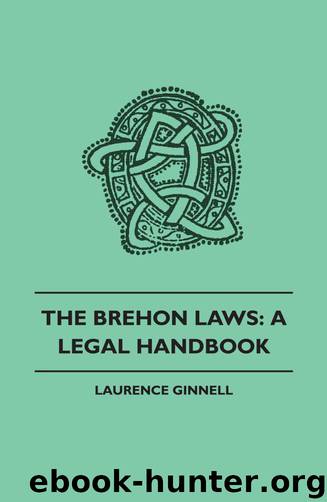The Brehon Laws: A Legal Handbook by Ginnell Laurence

Author:Ginnell, Laurence [Ginnell, Laurence]
Language: eng
Format: epub
Publisher: Read Books
Published: 2011-01-01T00:00:00+00:00
Sub-Section 4.—Devolution of Property.
UNITY of ownership in the clan, so long as it existed and so far as it extended, prevented the devolution of property to individuals in the same sense as in English law. Even to a late period a considerable portion of land was not inheritable by individuals, but remained unchangeably the property of the clan as an immortal corporation. To this land, therefore, no rules of devolution applied. Orba, or lands of inheritance, descended in three different ways:—
1. According to the rules of gavelkind. I place this first, not because it was the most important in historical times, but because it was the oldest, was once general, and certainly was the most unlike anything we are now acquainted with. Land held by a man outside his home farm, and which occupied an intermediate position between his private land and the common land of the clan, descended according to the Irish system of gavelkind, that is, on the holder’s death not only the particular land which had been thus held by him, but all the land of the same class belonging to his sept, was divided anew amongst the adult males of the sept. It was an unsettled system. Still it must be admitted that it gave some start in life, however crude, to young men who might otherwise have got none. On such a division of land, the amount of it that each person was entitled to receive was fixed in general theory by the law, subject to adjustment in each particular case by a court of twelve men who took differences of quality and other relevant facts into consideration. Their decisions do not appear to have been questioned. If they ever were questioned, no doubt an appeal lay to the brehons. Under this peculiar custom of descent women appear to have been excluded. The amount of land subject to the custom constantly diminished, the custom receding, as it were, from good land and extending to land little cultivated. I think the land subject to this custom must have been unfenced, but it is not so stated. It was that portion of the land of the sept over which an individual right of private property had not yet attained maturity, the interest of each holder not being ownership nor quite a life interest. A large proportion of the good land of Ireland must have been rescued from this custom a century or two before the birth of Christ, if it be true as stated that large quantities of corn were grown and exported in those centuries to Britain, Gaul, and Spain, a thing hardly possible if the land had remained unfenced and subject to this unsettled species of gavelkind. At the time of Cæsar’s arrival in Britain the land there was wholly unfenced, except the mounds and fallen timber that encircled the fortresses and clustering hamlets. There was no division into fields, the land being distinguished only as cleared and uncleared in respect of forest, and the people subsisting mainly on meat and milk.
Download
This site does not store any files on its server. We only index and link to content provided by other sites. Please contact the content providers to delete copyright contents if any and email us, we'll remove relevant links or contents immediately.
| Africa | Americas |
| Arctic & Antarctica | Asia |
| Australia & Oceania | Europe |
| Middle East | Russia |
| United States | World |
| Ancient Civilizations | Military |
| Historical Study & Educational Resources |
Cecilia; Or, Memoirs of an Heiress — Volume 1 by Fanny Burney(32067)
Cecilia; Or, Memoirs of an Heiress — Volume 3 by Fanny Burney(31463)
Cecilia; Or, Memoirs of an Heiress — Volume 2 by Fanny Burney(31413)
The Secret History by Donna Tartt(18188)
Sapiens: A Brief History of Humankind by Yuval Noah Harari(13994)
Leonardo da Vinci by Walter Isaacson(12809)
The Radium Girls by Kate Moore(11626)
Sapiens by Yuval Noah Harari(5125)
How Democracies Die by Steven Levitsky & Daniel Ziblatt(4966)
The Wind in My Hair by Masih Alinejad(4849)
Homo Deus: A Brief History of Tomorrow by Yuval Noah Harari(4692)
Endurance: Shackleton's Incredible Voyage by Alfred Lansing(4511)
Man's Search for Meaning by Viktor Frankl(4295)
The Silk Roads by Peter Frankopan(4275)
Millionaire: The Philanderer, Gambler, and Duelist Who Invented Modern Finance by Janet Gleeson(4107)
The Rape of Nanking by Iris Chang(4024)
Hitler in Los Angeles by Steven J. Ross(3803)
The Motorcycle Diaries by Ernesto Che Guevara(3789)
Joan of Arc by Mary Gordon(3787)
